Births
| | This section needs expansion. You can help by adding to it. (July 2016) |
| Years in Russia: | 1807 1808 1809 1810 1811 1812 1813 |
| Centuries: | 18th century · 19th century · 20th century |
| Decades: | 1780s 1790s 1800s 1810s 1820s 1830s 1840s |
| Years: | 1807 1808 1809 1810 1811 1812 1813 |
Events from the year 1810 in Russia
| | This section needs expansion. You can help by adding to it. (July 2016) |
| | This section needs expansion. You can help by adding to it. (July 2016) |
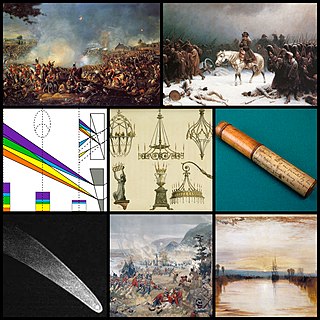
The 1810s was a decade of the Gregorian calendar that began on January 1, 1810, and ended on December 31, 1819.
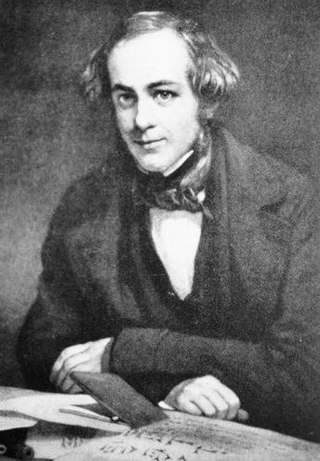
Sir Henry Creswicke Rawlinson, 1st Baronet, KLS was a British East India Company army officer, politician, and Orientalist, sometimes described as the Father of Assyriology. His son, also Henry, was to become a senior commander in the British Army during the First World War.

Mahmud II was the sultan of the Ottoman Empire from 1808 until his death in 1839. Often described as "Peter the Great of Turkey", Mahmud instituted extensive administrative, military, and fiscal reforms which culminated in the Decree of Tanzimat ("reorganization") that was carried out by his successors. His disbandment of the conservative Janissary corps removed a major obstacle to his and his successors' reforms in the Empire. Mahmud's reign was also marked by further Ottoman military defeat and loss of territory as a result of nationalist uprisings and European intervention.

Count Mikhail Mikhailovich Speransky was a Russian reformist during the reign of Alexander I of Russia, to whom he was a close advisor. Honorary member of the Free Economic Society (1801) and the St. Petersburg Academy of Sciences (1819). He later served under Tsar Nicholas I of Russia and was Active Privy Councillor (1827). Speransky is referred to as the father of Russian liberalism.

The Duchy of Warsaw, also known as the Grand Duchy of Warsaw and Napoleonic Poland, was a French client state established by Napoleon Bonaparte in 1807, during the Napoleonic Wars. It initially comprised the ethnically Polish lands ceded to France by Prussia under the terms of the Treaties of Tilsit, and was augmented in 1809 with territory ceded by Austria in the Treaty of Schönbrunn. It was the first attempt to re-establish Poland as a sovereign state after the 18th-century partitions and covered the central and southeastern parts of present-day Poland.

The Russo-Turkish War (1806–1812) between the Russian Empire and the Ottoman Empire was one of the Russo-Turkish Wars. Russia prevailed, but both sides wanted peace as they feared Napoleon's moves to the east.

The State Council was the supreme state advisory body to the tsar in the Russian Empire. From 1906, it was the upper house of the parliament under the Russian Constitution of 1906.
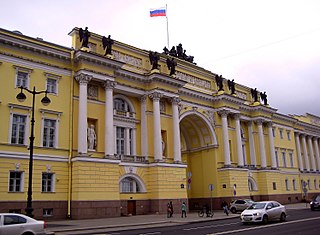
From 1711 to 1917, the Governing Senate was the highest legislative, judicial, and executive body subordinate to the Russian emperors. The senate was instituted by Peter the Great to replace the Boyar Duma and lasted until the very end of the Russian Empire. It was chaired by the Procurator General, who served as the link between the sovereign and the Senate; he acted, in the emperor's own words, as "the sovereign's eye".

The Kingdom of Italy was a kingdom in Northern Italy in personal union with Napoleon I's French Empire. It was fully influenced by revolutionary France and ended with Napoleon's defeat and fall. Its government was assumed by Napoleon as King of Italy and the viceroyalty delegated to his stepson Eugène de Beauharnais. It covered some of Piedmont and the modern regions of Lombardy, Veneto, Emilia-Romagna, Friuli-Venezia Giulia, Trentino, South Tyrol, and Marche. Napoleon I also ruled the rest of northern and central Italy in the form of Nice, Aosta, Piedmont, Liguria, Tuscany, Umbria, and Lazio, but directly as part of the French Empire, rather than as part of a vassal state.

Prince Viktor Pavlovich Kochubey ; was a Russian statesman and close aide of Alexander I of Russia. Of Ukrainian origin, he was a great-grandson of Vasily Kochubey. He took part in the Privy Committee that outlined Government reform of Alexander I. He served in London and Paris embassies as counsel, then as Ambassador to Turkey. In 1798 he was appointed to the board of College of Foreign Affairs and was made Count next year, but then Paul I of Russia exiled him. At the start of the reign of Alexander I, he joined the liberal Privy Committee that outlined Government reform of Alexander I. He was the Minister of Foreign Affairs in 1801–1802 and also Minister of the Interior until 1812, then in 1819–1825. Since 1827 he was the President of the State Council and Chairman of the Committee of Ministers. In 1834, he was granted the rank of Chancellor of the Russian Empire.

The Electorate of Hanover was an electorate of the Holy Roman Empire, located in northwestern Germany and taking its name from the capital city of Hanover. It was formally known as the Electorate of Brunswick-Lüneburg. For most of its existence, the electorate was ruled in personal union with Great Britain and Ireland following the Hanoverian Succession.

Ministry of War of the Russian Empire, was an administrative body in the Russian Empire from 1802 to 1917.
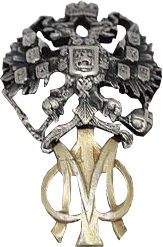
Ministry of Finance — one of the Russian Empire's central public institutions, in charge of financial and economic policy.

The First French Empire, officially the French Republic, then the French Empire after 1809 and also known as Napoleonic France, was the empire ruled by Napoleon Bonaparte, who established French hegemony over much of continental Europe at the beginning of the 19th century. It lasted from 18 May 1804 to 3 May 1814 and again briefly from 20 March 1815 to 7 July 1815, when Napoleon was exiled to St. Helena.
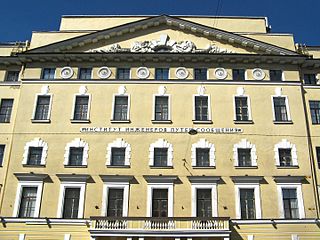
Emperor Alexander I St. Petersburg State Transport University (PGUPS) is a higher education institution specializing in railway transport.

Daugavpils Fortress, also known as Dinaburg Fortress or Dvinsk Fortress, is an early 19th century fortress in Daugavpils, Latvia. It is the only early 19th century military fortification of its kind in Northern Europe that has been preserved without significant alterations. The construction of the fortress began in 1810 by decree of Tsar Alexander I of Russia, in the atmosphere of increased tension before Napoleon's invasion of the Russian Empire in 1812. Construction of the fortress, due to Napoleon's invasion, lengthy delays, serious floodings and slow construction work, was fully completed only in 1878.

The Saint Petersburg Military Engineering-Technical University (Nikolaevsky), previously known as the Saint Petersburg Nikolaevsky Engineering Academy, was established in 1810 under Alexander I. The university is situated in the former barracks of the Cavalier-Guard Regiment where the university was founded.

Events from the year 1765 in Sweden
The Battle of Varvarin was fought on 5 September 1810 between Serbian Revolutionary forces supported by Russian troops and Ottoman forces near Varvarin, at the time part of the Ottoman Empire,. During the 10-hour battle, the Turkish army unsuccessfully attacked the Russians and Serbs, but was never able to push them out of their positions, retreating in the evening with heavy casualties.
![]() Media related to 1810 in Russia at Wikimedia Commons
Media related to 1810 in Russia at Wikimedia Commons